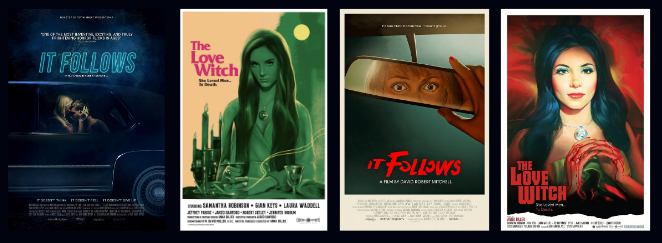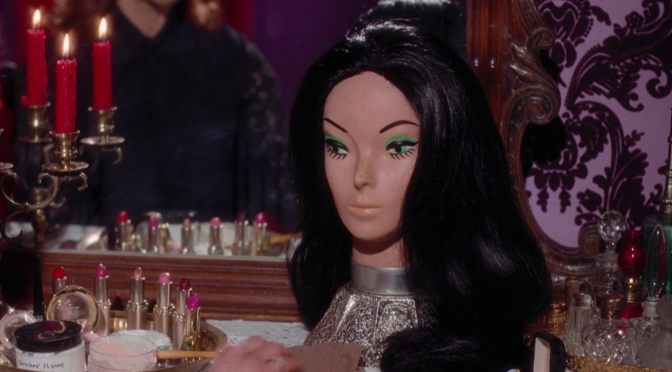So, goddesses, use perfume, wear high heels and makeup, learn to dress your hair in attractive ways, display flesh artfully, and know what to conceal…
The Love Witch
How about the girl in the yellow dress?
It Follows
PUTTING THE ‘FOLK’ IN HORROR
Folk horror is riding high in current circles of the fantastic, with recent auteur trips from Ari Aster and Robert Eggers redefining the subgenre away from its British origins. Despite these directors’ films centering American characters, the Aster-Eggers dominance remains rooted in classic Anglo-horror trappings: mysterious in-group versus naïve outlanders; religious fear; fertility rites; rural settings.
From a thoroughly American angle, the folk portion of the phrase calls not on inherited old-country lore but the eponymous Candyman (1992) and the hill-people of Texas Chainsaw Massacre (1974). From this angle, two well-received late-2000s films, It Follows (2014) and The Love Witch (2015), take on meaning beyond their surface appeal of minimalist suburban malaise and glamorous Sixties throwback. Folk horror’s aesthetics are expansive enough to include cultural fears native to the United States, interrogate racism and sexism underpinning horror as a genre and visual format, and embrace the abject–the eroding boundary between protagonist and threat, the utter horror of subjectivity.

David Robert Mitchell’s It Follows, and Anna Biller’s The Love Witch sum up as both of the classical story-kernels. A stranger comes to town. Boy meets girl. Superficially, this is where the similarity ends… and superficiality–more generously aesthetic, artifice, and style–is the hallmark of both movies. Biller’s intentional homage to and critique of Sixties Technicolor sexploitation achieves a seamless overall effect. Its hard lighting, false eyelashes, and screaming color theory is only the beginning of an affectionate and yet merciless look into the sexual and spiritual politics of second-wave feminism and beyond.
Antiheroine Elaine’s (Samantha Robinson, Once Upon a Time in Hollywood) classic car and beehive hairdo situate the viewer comfortably in their own expectations, only to ram up against modern automobiles and the jarring appearance of a cell phone. In the same way, It Follows unmoors the audience in time and only hints at space. Cathode-tube televisions rest comfortably in the same milieu as a futuristic e-reader shaped like a clamshell, and boundaries between suburb and city are constantly transgressed, to catastrophic effect. This visual rootlessness produces an uncanny valley of feeling, furthering the dream logic employed by both filmmakers into a pure nightmare.
FOR THE AESTHETIC
The Love Witch’s debt to British folk horror is plain yet filtered through the lens of American mores, fears, and assumptions. British classics such as Blood on Satan’s Claw (1971) and US inheritors like The VVitch (2015) make no bones about their handling of witchcraft and Satanism. The Love Witch plays with a layer cake of reference and meaning, its endpoint in the northern California redwoods far removed from British fens and the forest beyond the Puritans’ pale. Its rural-city divide and minority religious tensions are familiar folk-horror tropes, but the film’s Wiccan revivalists call to mind both the shoddy spirituality of Sixties feminism (think Margaret Murray’s pseudo-archaeology and its modern-day descendants in appropriative New Age communities) and the Satanic Panic of the Eighties.
Ostensibly heroic and liberatory, Elaine and her coven are ultimately hidebound, sexist, and murderous, joining the ranks of Hereditary’s ceremonial magicians and Midsommar’s Swedish cultists. Like Aster’s slipstream antagonists, the witches command the eye. Costuming is front and center, each scene laden with aesthetic cues, both narrative (Elaine’s rainbow-lined black coat) and meta (the very modern tag visible at the back of her underwear); a Renaissance Fair scene plays with layered meanings, as the reenactors are actually coven members and their bucolic scene masks ritual magic.
Folk horror’s double signification is the film’s hallmark, swimming in the liminal space between irony and earnestness, homage, and critique. Elaine’s initial glamour gradually degrades into a mimesis of itself, lampshaded by the scene in which Trish dons Elaine’s wig, lingerie, and makeup, leaving Elaine fighting a vision of herself. The overall effect is one of greasepaint, a fragile world of exaggerated details and a stratigraphy of artifice.
Meanwhile, It Follows traffics in a referentialism that at times feels playful; the seasoned horror viewer knows what happens to blond girls who have sex. The fun is distorted by the film’s lack of audience anchor: a period piece gives some sense of remove, while a body proves the monster has been killed. The eponymous it and its meandering circuit of the Detroit suburbs provide neither.
The telling phrase ruin porn, in this case, envelops both post-industrial settings and the intimate acts taking place in them; as Mark Binelli notes, Detroit’s threat is penetrative, transgressive, mirrored in Greg’s eventual death via intercourse with the image of his mother. Few cues are given to reassure the viewer of what time of year the movie takes place. School is in session, but Jay (Maika Monroe, The Guest) rarely attends. The story begins in a swimming pool, but autumn leaves are on the trees.
In one scene, the archetypal summer Slurpee is devoured while Jay wears a coat and boots next to her sister’s denim shorts. The opening shot pairs high heels with a barely-there pajama set, as though Annie is performing a got-laid-parade from her own family home. A recurring pinkness, bra straps, lingerie, and red fingernails calls to tropey horror sexuality, the abuse and destruction of the feminine, yet sex is posited as both what calls down the curse and frees the characters from it. This refusal to situate the viewer, to parcel out affirmative touchstones of reality, paired with heart-familiar visual horror coding, generates a meta-narrative of American horror. The film’s fears are old: the body polluted and the border crossed.
GENERATIVE TRAUMA
Folk means people, kind of like how discourse means people talking. If there’s one thing Americans fear, it’s sex–both in the bio-essentialist sense, of a non-male-coded body, and the active sense of coupling, dissolving, changing. Masculine-typical fears are projected onto the feminine body: the body is changed through intercourse, and so the soul. Heterosexual norms and desires are likewise projected: high heels and long hair denote willingness, and consent is negotiated as forethought, the masculine viewer’s interpretation of a feminine text.
Horror has long been hung on this binary, and horror has been heavily heteronormative as a result. It Follows, and The Love Witch are not immune to male-female polarity–Biller’s film requires it as a necessity of depicting Wicca, and Mitchell’s declines to float the possibility of it being transmitted through queer sex–and neither do they elude that other homegrown American fear, the racial Other. Indeed, both films are almost entirely white, and in both cases, it’s difficult to say whether this is unintentional, the result of passively racist American oversight, or very intentional.
It Follows is aware of its surroundings; Jay’s story begins in the suburbs and transgresses into the city for its denouement, with characters discussing the childhood sin of traveling past Eight Mile Road. Detroit’s urban decay and economic cramps are longtime codes for racial tension and the displacement of the fruits of the sins of white supremacy onto Black Americans. Queer-coded and multicultural San Francisco is abandoned by Elaine and the other witches for a milquetoast, nameless small town, big enough for a university and small enough that even the burlesque bar’s clientele knows about the local coven. This blank backdrop is painted fantasies of the young white feminine: tea rooms draped in Victorian lace and serenaded by harpists, lavish cakes, and flawless sexpot lighting.
Yet as Jay and Greg’s bodies are tainted by it, a nominally, literally, and intentionally sexual threat, Elaine’s fairy-tale world is invaded by her own reality. The bodily processes of food and sex are paired onscreen, a mocking flashback voiceover of Elaine’s father and husband critiquing her weight set against scenes of rich consumption. The abject–those parts of the self which are repulsive but inseparable–is brought from the shadows and made supertext. The cast-off female-coded body appears as a dividing line and as its own self-fulfilling prophecy.
Annie’s leg, bent out of use and proportion but still wearing its high heel.
Jay’s hair, rising in invisible hands.
Elaine’s gown, half-stripped from her by the archetypal mob.
Innate elements of the feminine self-made taboo by kyriarchy, historically masculine fears of sexual and racial Others, a mystic power which taints, changes, even empowers: these are the core of folk horror. In The Love Witch and It Follows, an American twist is added through pure aesthetic, a reliance on surfaces and signs–and inevitable, post-post-post-modern descent into the simulation. When life finally comes to mimic Elaine’s art, she’s left with blood on her hands, unsure which pieces of the scene are real and which dreams. When Jay, at last, considers that it may have been defeated, her only proof is shared misery. The truth of the abject is in its continual exclusion and renewal, a circuitous boundary-drawing: material reality, the truth of the body.
Citations and Further Reading
- Binelli, M. How It Follows Uses Detroit to Explore the Horror of Urban Decay
- Hauke, A. The Wicked Witch in the Woods
- Heller-Nicholas, A. An Interview with Anna Biller
- King, A. A Monstrous(ly Feminine) Whiteness
- Tucker, J. A Tour of American Folk Horror





